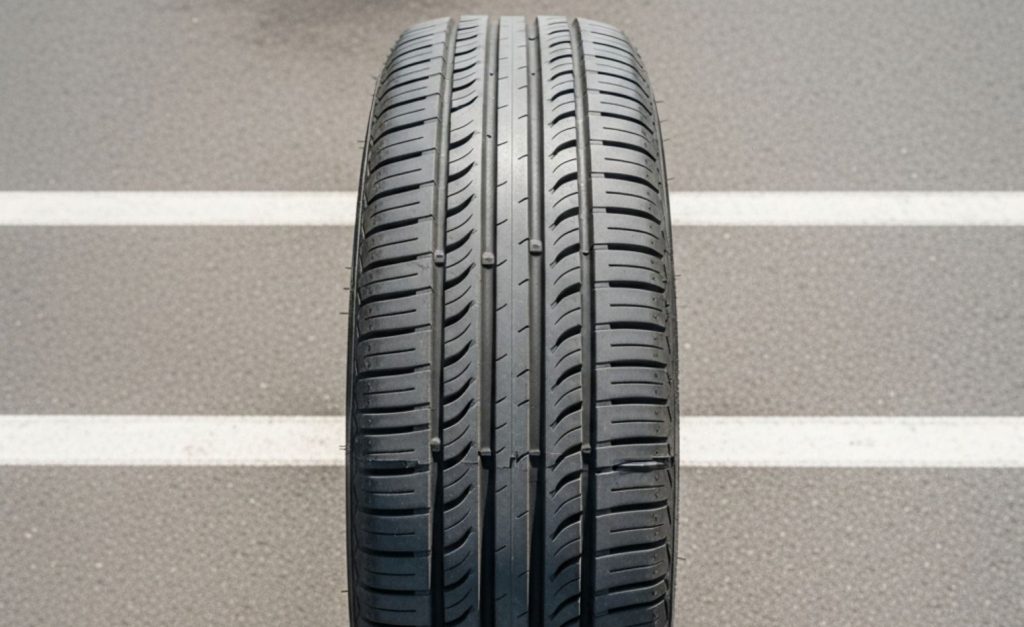
Car tires are undeniably one of the most critical safety components of any vehicle. They are the only point of contact between your car and the road, influencing acceleration, braking, steering, and overall stability. While tread depth is a commonly understood indicator of tire wear, the chronological age of a tire is an equally, if not more, crucial factor that often gets overlooked. Rubber, being an organic material, degrades over time, irrespective of its usage.
The Science Behind Tire Aging: Why Rubber Doesn’t Last Forever 🔬
To understand why tires have a finite lifespan, we must look at their composition and the environmental factors they encounter. Tires are not just simple rubber rings; they are complex structures made from a blend of natural and synthetic rubbers, carbon black, silica, reinforcing chemical agents, and fabric or steel belts. This sophisticated mixture is designed to provide grip, durability, and comfort. However, the very properties that make rubber flexible and resilient also make it susceptible to degradation over time through several processes:
- Oxidation: This is one of the primary culprits in tire aging. Oxygen in the atmosphere reacts with the polymer chains in the rubber. This process causes the rubber to lose its elasticity, becoming harder and more brittle. Heat significantly accelerates oxidation. Even when a car is parked, the tires are constantly exposed to oxygen.
- Ozonolysis: Ozone, a gas present in the atmosphere (especially in polluted urban areas), is highly reactive and aggressively attacks the double bonds in rubber molecules. This leads to the formation of cracks, typically visible on the tire sidewalls or in the tread grooves. These cracks can compromise the structural integrity of the tire.
- UV Radiation Exposure: Sunlight, specifically ultraviolet (UV) radiation, contributes to the breakdown of rubber compounds. Prolonged exposure can lead to discoloration, surface hardening, and the development of fine cracks. Cars parked outdoors for extended periods are more susceptible.
- Temperature Fluctuations (Heat Cycles): Tires experience a wide range of temperatures, from the cold of winter to the heat generated during driving and hot summer days. These cycles of heating and cooling cause the rubber to expand and contract repeatedly. Over time, this thermal cycling stresses the rubber and the internal structure of the tire, contributing to material fatigue and degradation. The heat generated during driving, especially at high speeds or with underinflated tires, is a significant aging accelerator.
- Lack of Use (Paradoxically): While it might seem counterintuitive, tires that are not used regularly can sometimes age faster in certain aspects. Modern tire compounds contain anti-aging waxes and oils that migrate to the surface of the rubber during use, providing a protective layer. When a tire is stationary for long periods (e.g., on a spare wheel or a rarely driven vehicle), this migration slows down, potentially leaving the rubber more vulnerable to ozone and oxidation.
- Internal Degradation: Aging doesn’t just affect the visible surfaces. The internal structure, including the steel belts and fabric plies, can also degrade. Moisture can seep in over time, potentially causing corrosion of steel belts, or the bonds between different layers can weaken. This internal degradation is often invisible from the outside but can lead to catastrophic tire failure.
These processes occur continuously from the moment a tire is manufactured. Therefore, even a tire that has never been mounted on a vehicle and has been stored in ideal conditions will still age.
Decoding Your Tire’s Age: The DOT Code 🔍
The single most important piece of information for determining a tire’s age is the DOT code, which is a string of characters mandated by the U.S. Department of Transportation but used globally. This code is molded onto the tire’s sidewall. While the full code provides information about the manufacturing plant and tire size, the crucial part for age determination is the last four digits (for tires manufactured since the year 2000).
- The first two of these four digits represent the week of manufacture. (e.g., „32” means the 32nd week of the year).
- The last two digits represent the year of manufacture. (e.g., „21” means the year 2021).
So, a DOT code ending in „3221” indicates the tire was manufactured in the 32nd week of 2021.
For tires manufactured before the year 2000, the date code usually consists of three digits, with the first two indicating the week and the last one indicating the year within that decade (e.g., „418” could mean the 41st week of 1998 or 1988). Any tire with a three-digit date code is now well over 20 years old and should be considered unsafe for use, regardless of its appearance or tread depth.
Finding the DOT code can sometimes be tricky as it might only be on one sidewall. If you don’t see the full code with the date, check the other side of the tire.
How Many Years is Too Many? Industry Recommendations and Manufacturer Stances 📅
There isn’t a single, universally mandated „expiry date” for tires in the same way there is for food products. However, a strong consensus exists among automotive experts, safety organizations, and many tire manufacturers regarding the safe service life of a tire.
General Industry Recommendation: Most experts and vehicle manufacturers recommend replacing tires six years after their date of manufacture, regardless of tread depth or visual appearance. Some may extend this to a maximum of ten years, but only with annual professional inspections after the fifth or sixth year.
Manufacturer Stances: Several prominent tire manufacturers, such as Michelin and Continental, generally state that tires are complex engineered products that do not have a fixed expiry date from manufacture as long as they are stored correctly before sale. They emphasize that service life begins when the tire is mounted and put into use. However, they also strongly recommend regular inspections by a qualified professional. Many still suggest a maximum service life of 10 years from the date of manufacture, after which tires should be replaced as a precaution, even if they appear serviceable and have adequate tread depth. For instance, Michelin recommends replacing tires 10 years after their manufacture date, even if they appear to be in good condition.
The 10-Year Absolute Maximum: Virtually all sources agree that no tire should remain in service, including the spare, for more than 10 years from its date of manufacture. The cumulative effects of aging, regardless of use or storage, render the tire potentially unsafe beyond this point. The rubber becomes too brittle, the internal components may have weakened, and the risk of sudden failure increases dramatically.
Visible and Invisible Signs of an Aged Tire ⚠️
While the DOT code is the definitive way to know a tire’s age, visual and performance cues can also indicate advanced aging:
- Cracking (Crazing/Weathering): Look for fine to significant cracks on the sidewalls and in the grooves between tread blocks. This is a classic sign of ozone damage and rubber embrittlement. Even small cracks can allow water to penetrate the tire’s internal structure.
- Bulges or Deformations: Blisters, bulges, or any unusual waviness on the sidewall or tread can indicate internal separation of the tire’s layers or belt damage, often exacerbated by age. These are extremely dangerous and require immediate tire replacement.
- Discoloration: While not always a sign of severe degradation, a faded or brownish appearance, as opposed to a rich black, can suggest advanced age and exposure to the elements.
- Hardness and Brittleness: As tires age, they lose their pliability. An old tire might feel noticeably harder. This reduces its ability to grip the road effectively, especially in wet or cold conditions.
- Loss of Performance (Invisible Danger): This is the most insidious aspect of tire aging. An old tire, even with deep tread, may offer significantly reduced grip compared to a newer tire. Braking distances can increase, and handling in emergency maneuvers can be compromised. This loss of grip might not be apparent during normal, gentle driving but can manifest suddenly when you need the tire to perform most.
- Frequent Loss of Air Pressure: While punctures are a common cause, older tires can sometimes lose air more readily due to the rubber becoming more porous or the bead sealing area degrading.
It’s crucial to understand that a tire can look perfectly fine, with plenty of tread depth, and still be dangerously old. The degradation process is often internal and not immediately visible.
Factors That Can Accelerate Tire Aging 🌡️☀️
Several factors can hasten the aging process of your tires:
- High Temperatures and Sunlight Exposure: Cars parked outdoors in hot, sunny climates will experience faster tire degradation. The combination of heat and UV radiation is particularly damaging.
- Coastal Areas: Salty air can also contribute to the degradation of rubber and the corrosion of internal steel belts if moisture ingresses.
- Infrequent Use: As mentioned earlier, vehicles that are rarely driven or stored for long periods (like classic cars, RVs, or trailers) might have tires that age prematurely if not stored correctly. The anti-aging chemicals in the rubber need the tire to flex to work their way to the surface.
- Improper Inflation: Consistently underinflated or overinflated tires experience excessive stress and heat buildup, which accelerates the aging process and can lead to structural damage.
- Overloading: Exceeding the vehicle’s load capacity puts immense strain on tires, generating excess heat and accelerating wear and aging.
- Poor Storage Conditions (for spare or seasonal tires): Storing unmounted tires in direct sunlight, near heat sources, or exposed to ozone (e.g., near electric motors) will significantly shorten their lifespan. Ideally, they should be stored in a cool, dark, dry place.
- Exposure to Chemicals: Solvents, fuels, oils, and harsh cleaning agents can damage rubber compounds.
The Dangers of Driving on Old Tires 💥
Using tires beyond their safe lifespan poses significant risks:
- Increased Risk of Blowouts or Sudden Failure: As rubber becomes brittle and the internal structure weakens, the tire is more prone to sudden, catastrophic failure, especially at high speeds or under heavy load. This can lead to a loss of vehicle control.
- Reduced Grip and Traction: Aged rubber loses its elasticity and ability to conform to the road surface. This results in diminished grip, particularly in wet or cold conditions, leading to longer braking distances and a higher risk of skidding.
- Compromised Handling and Stability: Old tires can affect the vehicle’s steering response and overall stability, making it less predictable, especially during emergency maneuvers.
- Vibration and Ride Comfort: Degraded tires may develop flat spots or become out-of-round, leading to vibrations and a harsher ride.
Prioritizing cost savings by keeping old tires in service is a dangerous gamble with potentially devastating consequences. The cost of new tires is insignificant compared to the potential cost of an accident.
Special Considerations: Spare Tires and „New Old Stock”
- Spare Tires: Often forgotten, the spare tire ages just like the tires on the road, sometimes even faster due to its static position and potential for different environmental exposure in the trunk or under the vehicle. Always check the DOT code of your spare tire and include it in your 6-10 year replacement schedule. Imagine having a flat tire only to find your spare is dangerously old and unusable.
- „New Old Stock” (NOS) Tires: Sometimes, you might find „new” tires for sale at a discount that were manufactured several years ago. While they haven’t been used, they have been aging. It’s crucial to check the DOT code before purchasing such tires. If a „new” tire is already 3-4 years old, its usable service life on your vehicle will be significantly reduced. Always aim to buy tires that are as fresh as possible, ideally less than a year old from their manufacturing date.
Recommendations for Tire Longevity and Safety 🛡️
- Know Your Tire’s Age: Regularly check the DOT code on all your tires, including the spare. Make a note of the manufacturing date.
- Regular Visual Inspections: At least once a month, and before any long trip, inspect your tires for signs of aging (cracks, bulges), damage, and wear. Also, check the tire pressure.
- Adhere to Replacement Guidelines: Plan to replace your tires every 6 years from the date of manufacture, or at an absolute maximum of 10 years, even if they have ample tread left. Consult your vehicle owner’s manual for manufacturer-specific recommendations.
- Proper Maintenance: Maintain correct tire inflation pressures, avoid overloading your vehicle, and have your wheel alignment and balancing checked regularly.
- Consider Your Climate and Driving Habits: If you live in a harsh climate or your tires are frequently exposed to extreme conditions, they may need replacing sooner.
- Store Seasonal Tires Correctly: If you use separate summer and winter tires, ensure the set not in use is cleaned and stored in a cool, dark, dry place, away from direct sunlight and ozone sources.
- Consult a Professional: If you have any doubts about the condition of your tires, have them inspected by a qualified tire technician. They can identify subtle signs of aging or damage that you might miss.
Conclusion: Safety Over Sentiment or Savings
While tread depth is a vital aspect of tire safety, the chronological age of a tire is a critical, non-negotiable factor. Rubber degrades over time due to complex chemical and physical processes, making older tires inherently riskier, regardless of their outward appearance or mileage. By understanding how to read the DOT code, recognizing the signs of aging, and adhering to recommended replacement intervals (typically 6 years, maximum 10 years from manufacture), drivers can significantly enhance their safety and that of their passengers. When it comes to tires, age is more than just a number – it’s a crucial indicator of their integrity and ability to keep you safe on the road. Don’t compromise on safety; ensure your tires are within their safe lifespan.














